lesson1 clothing
Lesson 1 Clothing 衣着
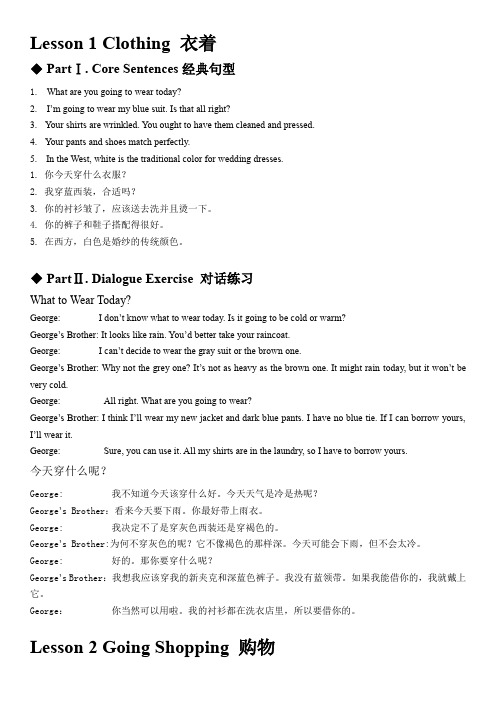
Lesson 1 Clothing衣着◆PartⅠ.Core Sentences经典句型1. What are you going to wear today?2. I’m going to wear my blue suit. Is that all right?3.Y our shirts are wrinkled. Y ou ought to have them cleaned and pressed.4.Y our pants and shoes match perfectly.5.In the West, white is the traditional color for wedding dresses.1.你今天穿什么衣服?2.我穿蓝西装,合适吗?3.你的衬衫皱了,应该送去洗并且烫一下。
4.你的裤子和鞋子搭配得很好。
5. 在西方,白色是婚纱的传统颜色。
◆PartⅡ. Dialogue Exercise 对话练习What to Wear Today?George: I don’t know what to wear today. Is it going to be cold or warm?George’s Brother: It looks like rain. Y ou’d better take your raincoat.George: I can’t decide to wear the gray suit or the brown one.George’s Brother: Why not the grey one? It’s not as heavy as the brown one. It might rain today, but it won’t be very cold.George: All right. What are you going to wear?George’s Brother: I think I’ll wear my new jacket and dark blue pants. I have no blue tie. If I can borrow yours, I’ll wear it.George: Sure, you can use it. All my shirts are in the laundry, so I have to borrow yours.今天穿什么呢?George: 我不知道今天该穿什么好。
四年级上册英语Unit1Lesson1SkirtandTrouser冀教版(三起)

教学设计一、教学目标1. 知识目标(1)能够听懂、会说、会读 Skirt 和 Trouser 这两个单词。
(2)能够听懂、会说、会读 I like 和 Do you like ? 这两个句型。
2. 能力目标(1)能够用英语描述自己喜欢的衣服。
(2)能够用英语询问并回答他人喜欢的衣服。
3. 情感目标培养学生的审美观,使他们懂得如何根据自己的喜好选择衣服。
二、教学内容本课主要教学 Skirt 和 Trouser 这两个单词,以及 I like 和Do you like ? 这两个句型。
通过描述和询问喜欢的衣服,培养学生用英语进行简单交流的能力。
三、教学重点与难点1. 重点:Skirt 和 Trouser 这两个单词的认读及运用。
2. 难点:I like 和 Do you like ? 这两个句型的运用。
四、教具与学具准备1. 教具:多媒体课件、实物衣服、图片等。
2. 学具:学生自带衣服、笔记本、文具等。
五、教学过程1. 热身(5分钟)(1)引导学生用英语进行自我介绍,例如:Hello, my name is I am years old. I like very much.(2)老师提问,学生回答,例如:Do you like clothes? What kind of clothes do you like?2. 课堂导入(10分钟)(1)展示实物衣服,引导学生用英语描述,例如:This is a skirt. This is a trouser.(2)老师提问,学生回答,例如:Do you like this skirt? Do you like these trousers?3. 新课呈现(15分钟)(1)讲解 Skirt 和 Trouser 这两个单词的用法,让学生跟读,确保发音正确。
(2)讲解 I like 和 Do you like ? 这两个句型的用法,让学生跟读,确保发音正确。
4. 课堂练习(10分钟)(1)小组活动:学生分成小组,用 Skirt 和 Trouser 这两个单词以及 I like 和 Do you like ? 这两个句型进行交流,例如:I like this skirt. Do you like these trousers?(2)个人展示:学生自己选择一件衣服,用英语描述并询问他人是否喜欢,例如:I like this dress. Do you like my dress?5. 课堂小结(5分钟)六、板书设计板书Unit 1 Lesson 1 Skirt and Trouser板书内容:1. Skirt 和 Trouser 这两个单词的写法及含义。
Unit1Lesson1SkirtandTrousers(教案)冀教版(三起)英语四年级上册

教案:Unit1 Lesson1 Skirt and Trousers一、教学目标1. 知识目标(1)能够听懂、会说、会读单词:skirt, trousers, dress, shorts, sports suit。
(2)能够运用所学单词和句型介绍衣服并进行简单的问答。
2. 能力目标(1)能够正确使用颜色单词和服装类单词描述衣服。
(2)能够用英语进行简单的购物交流。
3. 情感目标培养学生的观察力、想象力和创造力,提高他们对英语学习的兴趣。
二、教学内容1. 单词:skirt, trousers, dress, shorts, sports suit。
2. 句型:What colour is it? It’s What’s this? It’s三、教学重点与难点1. 重点:单词skirt, trousers, dress, shorts, sports suit 的认读及运用。
2. 难点:句型What colour is it? 和What’s this? 的运用。
四、教具与学具准备1. 教具:课件、衣服图片、衣服实物。
2. 学具:课本、练习册、彩笔。
五、教学过程1. 热身(5分钟)(1)与学生进行简单的英语交流,询问他们今天的天气和心情。
(2)引导学生复习颜色单词:red, yellow, blue, green, white, black。
2. 引入(10分钟)(1)向学生展示衣服图片,引导学生用颜色单词描述衣服。
(2)引导学生观察衣服图片,发现衣服的分类。
3. 呈现(10分钟)(1)向学生展示新单词:skirt, trousers, dress, shorts, sports suit。
(2)引导学生跟读单词,并解释单词的意思。
4. 练习(10分钟)(1)分组进行角色扮演,让学生用所学单词和句型进行对话。
(2)邀请几组学生上台表演,给予表扬和鼓励。
5. 巩固(10分钟)(1)让学生分成小组,用所学单词和句型编写小故事。
服装专业英语词汇.

Chapter 1 The Introduction of Clothing Lesson 1 ClothingWords and Phrases:clothing 服装,服饰,衣服garment 衣服,服装wear 服装,衣服,穿戴物cloth 织物,布,衣料fabric 织物,面料,布textile 纺织品,织物,纺织原料leather 皮革,皮革制品style 款式,式样,时尚,风度,格调fashionable 时髦人物;时尚的dress 礼服,连衣裙form 造型;人体模型fashion-show 时装展览,时装表演runway 时装天桥functional 机能的,功能的jeans 牛仔裤,紧身裤,粗斜纹棉布裤T-shirt T恤衫,短袖圆领汗衫legs 裤脚hat 帽子shoe 鞋子collection 服饰系列;时装展览,时装发布会ball gown 晚会礼服,正规礼服***fur 毛皮drape 立体裁剪wrap 包裹,围裹fit 合身,使合身decorate 装饰weave 梭织,织法knit 针织,针织服装twine 合股,搓,交织,缠绕fiber 纤维power loom 动力织布机Scottish kilt 苏格兰褶裥短裙Javanese sarong 爪哇纱笼围裙pin 大头针,别针belt 皮带,腰带,肩带uncut 不裁剪的,未经裁剪的gusset 三角形衬料chemise 直筒连衣裙,女式无袖衬衣remnant 剩余,零料waste 废料,废纱quilt 被子;绗缝(v)Lesson 2 Functions of Clothing Words and Phrases:gender 性别jersey 紧身运动套衫;平针织物accessory 服饰品,配件,辅助设备pad 衬垫,肩垫trend 时尚,流行,趋势professional buyer 专业采购员,专业买手jersey suit 针织套装sweater 运动衫;针织套衫;毛衣cloche hat 钟形女帽pants 裤子,长裤sportswear 便装;运动服装elaborate 精致的,精巧的aesthetic 美学地,审美的,有美感的stay 滚边,窄带slim 细长的,苗条的fashionability 时尚,流行femininity 女性气质,女人味collar 衣领,上领cuff 袖口raw material 原材料man-made 人造的,合成的tortoiseshell 龟甲,玳瑁tailored suit 西式套装,精做西装trousers 裤子,长裤(英式)look 风貌,风格;款式,外表,姿态Poor Look 贫穷装,破旧型款式Chapter 2 Materials for Clothing Lesson 3 FibersWords and Phrases:comb 梳;梳理(v)twist 捻,拧,编织yarn 纱,纱线cultivated silk 家蚕丝moth 蛾,蛀虫cocoon 茧,蚕茧filament 长丝blend 混合flax 亚麻,麻布handle 手感staple 主要产品,原材料synthetic fiber 合成纤维cellulosic fiber 纤维素纤维reconstituted 再生的,再造的wood pulp 木纸浆spinning 纺纱rayon viscose 粘胶人造丝artificial silk 人造丝acetate 醋酸lyocell 天丝,莱塞尔纤维nylon 尼龙,酰胺纤维polyester 聚酯acrylic 丙烯酸的spinneret 吐丝器,喷丝头bulk 蓬松度stiffness 硬挺度,硬挺性resist bending 抗弯曲resilience 回弹,回弹性能cross-like 十字形的Y-shaped Y形的bean-shaped 豆圆形的easy care 免烫,洗可穿durability 耐久性,耐用性saw-tooth 锯齿形的cotton gin 轧棉机,轧花机spandex 弹力纤维stretch 弹力,弹性,松紧matte 暗淡色调moisture absorbency 吸湿性substitution 代替物,替换steam cleaning 蒸汽喷洗;蒸汽清洗thermal retention 保暖性wrinkle 皱褶,折皱stiff hand 硬手感iron 熨斗,烙铁linen 亚麻,亚麻制品dry cleaning 干洗dry-cleaned 干洗Lesson 4 Fabric Words and Phrases:interlace 交织criteria 标准stability 稳定性embroider 刺绣braid 编织物,滚带,辫子pile 绒毛,绒头pile fabric 绒毛织物,起绒织物,植绒织物backing 衬里,底布,背衬bias 斜裁,斜纹路,斜条crossway 斜纹,交叉pattern 纸样,裁剪样板;花纹组织;图案piece 衣片,裁片mark 标记,符号grain line 经向线,经向标志classic 经典的,传统(服装)hand-crafted 手工制作的non-woven 非织物,无纺的felt 毛毯,毡interlining 衣服衬里weft 纬纱,纬向warp 经纱,经向horizontal 水平的,地平线的vertical 纵向的,垂直的,直立的chequered 格子花纹的,方格图案的twill 斜纹布,斜纹图案herringbone structure 人字形结构jacquard 提花织物,提花机satin 缎子,绸缎rib 罗纹velvet 经绒,丝绒,天鹅绒velveteen 纬绒,棉绒,平绒double-face 双面的cloque 泡泡纱shrink 收缩,缩水quilted effect 绗缝效果blister 起泡matelassé马特拉塞凸纹布weft-knitted fabric 纬编针织物warp-knitted fabric 经编针织物interlock 双罗纹,联锁,使连接loop 毛圈,线环loop fabric 毛巾织物,毛圈织物flexible 弯曲的,弹力的tension 拉力,张力shaped 成型的fashioned knitting machine 成型针织机inlay 镶嵌,嵌入intarsia 嵌花,镶嵌装饰lingerie 女式内衣openwork 网眼式,网状织物net 网眼织物fleece 羊毛,似羊毛物,羊毛标签terry cloths 毛圈织物corduroy 灯芯绒laminates 粘合布,多层布flocked fabric 植绒织物finish 织物整理,后整理washing 洗涤pressing 熨烫,压呢,烫衣tactile 手感,触感novel 新奇的,新颖的permanent 永久的temporary 暂时的white dye 增白,加白cellulose 纤维素bleach 漂白,褪色rough 布面毛糙的smooth 光滑的,滑爽的cropping 剪除,剪去singe 烧去(布匹的)茸毛calendar 轧光整理glaze 上光,极光;光泽,色泽engrave 雕刻,刻印pluck 拔毛,拉毛nap 衣料起毛lay 铺料bottom (织物)底色;(衣服)下摆,下装cutting 裁剪napped fabric 起绒面料back (织物)背面fleecy 蓬松的,羊毛似的stripe 条纹,条子heat-setting 热定型coating 涂层,上胶thermoplastic 热塑性;热塑性塑料weather-wear 风雨衣waterproofing 防水,绝湿flame proofing 抗燃,阻燃,防火Lesson 5 Fabric Performance Words and Phrases:comfort 舒适性ease of care 易护理性shape retention 保形性abrasion resistance 抗磨损性colorfastness 染色坚牢度tensile strength 抗张强度canvas 帆布sheer 透明薄织物;透明薄纱open-weave 稀薄组织spring 反弹,弹回resiliency 弹性,跳回crush 压皱,揉皱flatten 拉平rub (织物的)擦伤痕pill 起球fade 褪色;凋谢chlorine 氯denim 斜纹粗棉布,牛仔布madras 马德拉斯狭条衬衫布plaid 方格布,方格呢;格子花纹bleed (印染等)渗色wicking ability 吸附能力stretchability 拉伸性能perspiration 汗;出汗terry cloth (毛巾,围巾等)两端留有绒穗的物品breathability 透气性penetrate 穿透,透过rubber boots 橡胶靴,橡胶长筒靴raincoat 雨衣arm 袖子swimsuit 女游泳衣air vents 透气孔skipants 滑雪裤ironing 熨烫folding 折叠hand wash 手洗washability 可洗性stain and spot resistance 防沾污性upholstery 室(车)内装饰wrinkle-resistant 防皱处理,耐褶皱性wrinkle resistancy 抗皱性,抗皱处理rayon 人造丝织物,人造丝durable press 耐久压烫width 幅宽bulkiness 蓬松性,蓬松度light-weight 轻量medium-weight 中厚heavy-weight 厚重tweed 粗花呢technologist 工艺师hard wear 经穿,耐磨swatch 小块样布;样品,样本lamination 粘合衬interweave 交织,混合reversible 双面织物weatherproof 防风雨的Lesson 6 Findings and Trims Words and Phrases:fingdings 服装附件shell fabric 面料inter lining 衣服衬里interfacing 粘合衬stiffen 使硬buttonhole 扣眼Silesia 西里西亚里子布mill 缩绒,缩呢stay tape 定位带,胸衬条,牵条pocket mouth 袋口wadding 填絮,软填料,衬垫shoulder pads 垫肩,肩衬,护肩thickness 厚度,密度sponge rubber 橡胶海绵,泡沫橡胶Glissade 格里萨特里子布over-garment 大衣,罩袍slippery 手感滑的,易脱落的slip 活络里子,女式长衬裙machine cotton and silk 缝纫机用棉线,丝线reel 线轴cop 纺锤状线团basting cotton 粗缝棉线,绗缝棉线button-hole twist 锁钮孔线hank silk 丝线团zipper 拉链fastener 紧固件slide tab 拉链头子,拉链滑块button 纽扣slit 缝,裂口;开衩(v)hooks and eyes 钩眼扣子;风钩thread loop 线环snap 按钮,钩扣cord 线绳,滚条linen thread 麻线elastic 松紧带;弹性织物stretchable 有弹性的tape 狭幅织物,狭带;牵条,贴边label 标签,商标linear trim 线形饰边ribbon 丝带,缎带,饰带passementerie 边饰,金银线镶边fringe 毛边,流苏tassel 穗,流苏lace 网眼织物,网眼花边,蕾丝airy 透气的buckle 扣子,带扣clip 别针,首饰别针toggle 套环,套索扣ligne 莱尼(纽扣规格:1莱尼=0.633毫米)trademark 商标,牌号embroiderer 绣花机;绣花工Chinese frog 中国盘扣Chapter 3 Fashion DesignLesson 7 Texture, fabric patterns and color Words and Phrases:texture 织物组织;肌理,纹理hand 手感silhouette 轮廓two-dimensional 二维的,平面的craft 手艺,手工;手工艺品行业shiny 发光的,有光泽的snugly 舒适地,紧密地,整洁干净地crepe 绉绸;绉布low-luster 光泽暗淡的,无光泽camouflage 伪装,掩饰,保护色,迷彩dye 颜料,染料;染色neutral 中性色dark color 深色,暗色crisp 挺括,挺爽spongy 海绵状的lofty 蓬松的,弹性outerwear 外衣,外套,户外穿服装intrinsic characteristic 内在特性geometrics 几何图形flora 花卉,植物border 边纹,镶边,滚边light 淡色,浅色;光泽dark 暗色,深色overall 宽大罩衫,工作罩衣motif 基调,基本图案,基本色调hipline 臀围线waistline 腰围线,腰节线chevron 山形,人字形;波浪形prints 印花,印花布scale 比例;比例尺;等级;样卡hue 色相chroma 纯度;色度saturation 色度;纯度;饱和度dusty 灰暗的,不明朗的gray-blue 灰蓝色value 明度tint 色泽,色彩;淡色shade 色调,明暗程度professional 自由职业者,专家expert 专家,内行,能手interrelationship 相互关系consumer 消费者haute couture 高级女式时装toile 试穿服装,样衣calico 平布,白布,印花布,棉布couturier 时髦女服商店,时髦女服商/女设计师model 时装模特,商品模特;型号;模型sketch 草图,速写Lesson 8 Basic principles of design Words and Phrases:proportion 比例contour 轮廓,外形:略图height 身高waist 腰部bodice 上衣片,大身,女装紧身上衣,紧身胸衣shoulder 肩宽,肩flatter (画像等)美于(真人或实物)ratio 比;比例junior 少年,瘦小的女服尺寸,少女型empire waist 帝国式腰线(高腰节)exaggerate 夸大,夸张heavyset 体格魁伟的balance 平衡appealing 吸引力unity 协调,统一off-center 偏离中心的on-center 居中opening 开襟padded shoulders 垫肩military suit 军装full skirt 宽裙,喇叭长裙clinging 紧身的,贴身的knit top 针织上衣oversize 特大型,特大尺寸,尺寸过大line 型,款式;线条,轮廓;系列;衬里visual illusion 视错觉,错视princess seams 公主线strapless 无吊带,无肩带asymmetrical 不对称的fad 流行一时的服装;流行快潮;一时风尚popular 流行的,普及的mauve 紫红色的;淡紫色的chartreuse 鲜嫩的黄绿色earth shoe 大地鞋rhinestone 人造钻石jewelry 首饰,珠宝饰物miniskirt 超短裙,迷你裙paratrooper pant 伞兵裤punk-rock 朋克-摇滚safari 猎装;淡土黄色A-line A字形线条,A型造型set-in 装袖,另外缝上的kimono 和服;连袖;和服式女晨衣raglan 插肩,插肩袖;插肩袖大衣jacket blazer 运动夹克cardigan sweater 卡蒂冈毛衫,开襟式毛衫tailored 定做的,合身的,精做的mink coat 貂皮大衣pendulum 钟摆swing 曲线形轮廓button-down shirt (前开襟纽扣的)传统衬衫skinny 消瘦的;细窄的V-neck V形领Lesson 9 What do fashion designers do Words and Phrases:specialize 专门从事,专门研究menswear 男服women-wear 女式服装children-wear 童装tailoring 缝制,裁剪业;裁缝工艺,成衣工艺casual-wear便服,轻便装knitwear 针织品,针织衣物jersey-wear 针织物;弹力针织物lingerie 妇女贴身内衣occasion-wear 应时服装;特定场合服装club-wear 俱乐部服装,娱乐服饰evening-wear 晚礼服nightwear 晚服,夜间家常服millinery 女帽,妇女头饰,女帽制造商footwear 鞋袜(统称);鞋类(总称)taste 风格,审美力organic fiber 有机纤维limited edition 限量版,限量发行的extraordinarily 非凡,特别,使人惊奇art critic 艺术批评家modernity 现代性,现代状态theatrical 夸张的,戏剧性的clothe 给⋯⋯穿衣,盖上artwork 插图,艺术作品color-block 色块pop art 通俗艺术,波普艺术Surrealist-inspired 超现实主义灵感来源的Lesson 10 The Evolution of Fashion Words and Phrases:high-priced 高档价格outfit 服装,全套服装trend setter (服装式样)创新人coverage 新闻报导glossy 有光泽的window display 橱窗展示,橱窗陈列specialty store 专卖店retailer 零售商pleated trousers 有褶裤slightly 苗条地,瘦长地taper 锥形的;使成锥形cuffed 翻边的,折边的promotional 促销的,推销的budget 预算,安排knock off 翻制设计,翻印本minimize 最小化popularity 流行,普及fabrication 制造,生产mass merchandiser 超级市场discounter 折扣商店sale rack 展销,促销jobber 批发,批发商fashion cycle 时装界saturate 渗透,充满,饱和fashion curve 流行的周期曲线announce 发布,预告,宣布forecaster 预测者signal 信号,暗号,标志advertising agency 广告公司consumer-product company 消费产品公司corporation 公司,企业pipeline 流水线consultant 顾问supply chain 供应链timeline 时间轴executive 执行部门,经理主管人员decision-making 决策的interview 面谈,访问anticipate 预期,预料,希望fine-tune 微调fragment 碎片,片段time-base 时间基线,时间坐标strategy 战略,策略preference 偏爱,喜爱Lesson 11 Tools to Predict Fashioncompile 编辑,搜集(资料)mode (服饰的)式样,风尚,风气,流行fee-based 以收费为基础subscription 订阅mainstream 主流forefront 最前部,最前沿street fashion 街头服装,街头服饰fashionist 时尚追随者;时装店主periodic 周期性的,定期的,循环的Lesson 12 The Fashion-design Process Words and Phrases:private label 商店标签;独立设计师标签muslin 平纹细布;[美]棉布,薄纱织物board 熨衣垫板flat pattern 平面纸样hand-cut 手工裁剪closure 服装闭合件vendor 厂商,卖家flat 平面图,效果图sample maker 样衣制作师pattern maker 样板师,打样师scale 比例;缩尺;比例尺;等级;样卡specification 规格;明细表;产品说明书assistant designer 助理设计师cost sheets 成本核算表sales sheets 销售报表fashion consultant 时装顾问,服饰顾问wardrobe (个人的)全部服装,行头;衣柜,衣橱custom designer 定制服装设计师dressmaker 裁缝工;女服裁缝师fashion illustrator 时装画stylized sketch 效果图artistic achievement 艺术成就pose 造型,姿态makeup 化妆;化妆品hair style 发型,发式Lesson 13 Models Words and Phrases:try out 试穿,试验supermodel 超级模特spectacular 公开展示的,展览物adjunct 附属物,附件,助手catwalk (舞台等的)天桥photogenic 特别上镜的,适合于拍照的mode agency 模特介绍所,模特经纪所fair 博览会,商品交易会,商品展览会counterpart 对手glitz 闪光的,眩目的fetish 偶像gothic clothing 哥特式服装trunk show 展销Lesson 14 Accessory Design Words and Phrases:glove 手套handbag 女用手提包,旅行包scarf 围巾,披巾,披肩stocking 长袜bow tie 蝴蝶结leg warmer 暖腿套,护腿leggings 儿童护腿套裤,开裆裤,袜筒necktie 领带,领结ascot tie 阿司阔领带,领巾式领带bolo tie 保罗领带,饰扣式领带clip-on tie 夹式领带necklace 项链suspenders 背带,吊带tights 裤袜,紧身衣裤Islamic headscarf 伊斯兰头巾skullcap 无檐便帽,瓜皮帽turban 女式头巾,穆斯林头巾semi-precious gemstone 半宝石的ruby 红宝石sapphire 蓝宝石,人造白宝石emerald 翡翠,绿宝石brooch 胸针,领针,扣花,胸饰bracelet 手镯,腕饰物pierce 刺穿,刺破earlobe 耳垂belt 腰带dinner jacket 小礼服,晚宴夹克礼服purse 女用小包,小钱袋tissue 薄纱,餐巾纸hairbrush 发刷gauntlet 长手套,防护手套mitten 连指手套sheath 鞘,套,外层覆盖物,外包物locket (装有照片或贵重金属纪念品的)项链pendant 垂饰,挂件;有垂饰的项链teenage wear 少年装bridal 婚礼服formal 正式的ready-to-wear 高级女装成衣fashion-conscious 时尚感的well-ventilated 透气的stylish 时尚的,时髦的Chapter 4 Garment constructions Lesson 15 Principles of Pattern Making Words and Phrases:seam line 接缝线;沿缝construction line 结构线shape 体形,身段dart 省道,缝褶semi-fitting 半紧身的easy fitting 穿着舒适的block 原型,裁剪样板ease 松份,放松pleat 打褶,褶裥godet 三角布(用以放宽衣裙下摆),裆布puff 尖角布;皱褶;胖褶bell 喇叭口;降落伞衣;钟形物tuck 横裥,活裥,塔克;打褶,打裥gather 褶裥,碎褶;打褶裥cone 锥体,锥形peplum 腰褶panel 嵌条,饰条,布块flap 前门襟;袋盖;帽边seam allowances 缝头,缝份basic seam 基本线,基本缝纫结构线enclosed seam 封边缝,止口缝hem 贴边,卷边,下摆,脚口折边fray 磨损facing 挂面,贴条,贴边notch 刀口,刀眼;切口;打刀眼foldline 折边线,对折线,折叠线toile pattern 样衣纸样industrial pattern 工业用纸样nett pattern 净样pocket placing 袋位pleat line 裥位线decorative stitch line 装饰辑线punch hole 孔位记号;穿孔gore 衣片,拼块,三角布fullness 丰满度raw edge 毛边neckline 领围线armhole 袖窿fish-eye dart 鱼眼形省道commercial placement 商业纸样的处理方法placket 开口,衣袋yoke 过肩,育克,覆肩hip line 臀围线rickrack 波曲形花边,荷叶边waist dart 腰省armscye 袖窿french dart 曲线省,刀背缝Lesson 16 Flat Pattern-making Words and Phrases:draft 样板,原图,草案fifth-scale block 1:5纸样full-scale blocks 原尺寸,实际尺寸measurement 围度,尺寸rever 翻边,翻领,翻袖tops 上装selvedge 织边,布边,边缘waistband 腰带cut-and-sew 裁剪成型(相对于全成型针织服装成衣法)over-locker 拷边机,包缝机knitted rib 针织罗纹fully-fashioning 全成型的wastage 损耗basic block 原型bust 胸围,胸部chest 前胸neck 颈部,领部wrist 腕,腕部ankle 踝骨,脚脖nape 颈背,后颈rise 立挡,直裆high ankle 上踝围nape to waist 后腰长front shoulder to waist 前肩线至腰线长armhole depth 袖窿深waist to knee 腰线至膝围线长waist to hip 腰线至臀围线长waist to floor 腰线至地面长body rise 裆深sleeve length 袖长sleeve length(jersey) 紧身衫袖长Lesson 17 Draping Words and Phrases:muslin 平纹细布style-line 造型线,款式结构线true 调整,修形crosswise 横向的test fit 裁剪前的试样baste 用长针脚粗缝prototype 原型,模型,样板;标样,样品mannequin 人体模特,橱窗模特sloper 服装尺寸样板single-ply 单层bill of materials 材料单replica 副本zoom in 放大zoom out 缩小Lesson 18 Terminology and Pattern Landmarks Words and Phrases:center front neck 前中领口点center back neck 后中领口点center front waist 前腰中点center back waist 后腰中点center front bust level (between bust points) 胸间距side front (princess) 前公主线side back (princess) 后公主线mid-armhole front 前袖窿中mid-armhole back 后袖窿中shoulder tip 肩点shoulder at neck 颈肩位armhole ridge or roll line 袖窿脊或拨折线plate screw 袖板螺丝armhole plate 袖板roller wheels 滚轮height pedal 高度踏板front bodice 前衣身back bodice 后衣身front central line(FCL) 前中心线back central line(BCL) 后中心线shoulder neck point (SNP) 侧颈点shoulder point (SP) 肩点shoulder dart 肩省necklace line (NL) 颈围线front neck point (FNP) 前颈窝点sleeve sewing notch 袖片对位点(刀眼)sleeve central line (SCL) 袖中线front pitch 前袖窿吻合点back pitch 后袖窿吻合点armhole line (AL) 袖窿弧线underarm point 腋点bust point (BP) 胸高点,乳点bust line (BL) 胸围线side seam (SS) 侧缝线waist line (WL) 腰线waist dart 腰省hip line (HL) 臀围线top hip line (THL) 上臀线middle hip line (MHL) 中臀围线balance mark 对位记号crown 袖山crown ease 袖山吃势crown notch 袖山对位剪口bicep-upper arm girth 上臀围elbow line (EL) 肘围线head size (HS) 头围knee line (KL) 膝围线increment 档差grade rule 放码规则,推挡规则bulk fabric 大货面料full-size 原尺寸的,实际尺寸的circumference grading 围度推挡girth 周长,围长length grading 经向推挡width grading 纬向推挡uneven grading 不均匀推挡Chapter 5 SewingLesson 19 Sewing Equipments Words and Phrases:coarse 粗的fine 细的thimble (手工缝纫用的)顶针,针箍beeswax 蜂蜡,蜂蜡包bent-handle 弯把thread clippers 纱剪刀pinking shears 锯齿剪,花边剪zig-zag 曲折线条,锯齿形,曲折形,人字形seam ripper 拆线器rip out 拆除,拆开machine-stitched 机缝的tape measure 软尺,带尺,卷尺yard stick 码尺,直尺skirt marker 裁裙片样板tracing wheel 插盘;点线轮,描样手轮tracing paper 插图纸graphite paper 石磨纸tailor’s chalk (裁缝用)划粉attachment 附件cording foot 嵌线压脚,滚边压脚piping foot 滚边压脚gathering foot 碎褶压脚shirring 多层收皱,抽褶,平行皱缝roller foot 双边固定轮压脚suede 人造麂皮,小山羊皮,起毛皮革,绒面革vinyl 聚乙烯基织物invisible zipper foot 暗拉链压脚narrow hemmer foot 狭卷边压脚loop turner 翻带器spaghetti strap 细肩带bodkin 穿带用的钝针,粗长针;锥子ribbon 带,丝带,缎带,饰带casing 抽带管dress form 人体模型架,胸架steam and dry iron 蒸汽电熨斗ironing board 熨衣板sleeve board 压袖板,烫袖板seam roll 袖馒头,袖烫垫tailor’s ham 布馒头,馒头烫垫point presser 马凳,烫凳,小烫台,小烫板needle or velvet board (供绒毛织物整烫的)针毯烫垫velvet 天鹅绒press mitt 手套式烫垫press cloth 熨烫垫布,熨烫衬布scorch 烧焦,枯萎the lock stitch machine 锁式线迹缝纫机the zigzag machine 锯齿形锁缝缝纫机,曲折缝缝纫机tricot knits 经编织物applique lace 贴饰花边overcast 覆盖,遮盖,包边缝纫the over-lock machine 包缝机,拷边机the safety stitch over-lock machine 安全线迹包缝机spool 线团straight-stitch 直线线迹stitch 针脚,线迹;缝法,缝线monogram 字母组合,交织字母over-casting 包边,锁边blind-stitching 暗针,暗缝线迹mending 织补,缝补;修理lockstitch 锁式线迹;锁缝bobbin 筒管,筒子rotary 旋转的,轮转的rim 边,缘;轮缘lever 杠杆shuttle (缝纫机的)滑梭hosiery 男袜,男用针织品microprocessor 微处理机computerize 给⋯⋯装备计算机Lesson 20 Sewing Process Words and Phrases:tack 粗缝,假缝pierce 刺入;刺穿;穿透wrinkle-free 不皱的template 模板unwrinkled 将(皱纹)弄平ply 织物层数feeding 推布,送料apparatus 仪器,装置,器皿,用具stack 叠,堆,堆积于jaw 夹片,虎钳牙grip 夹具,夹子;夹紧,抓住conveyor 传播者,运输设备aerodynamic 空气动力学的,气体动力学的suction 吸入,抽吸remainder 剩余物,其余的人,余数convex 凸的,凸面的vertex 顶点back tack 倒回针backstitch 回针,倒钩针basting stitch 假缝线迹blanket stitch 饰边缝线迹,锁缝线迹buttonhole stitch 锁眼线迹chain stitch 链式线迹cross-stitch 十字线迹,人字线迹,十字形刺绣线迹darning stitch 织补线迹embroidery stitch 绣花线迹hemming stitch 卷边线迹overhand stitch 对接缝线迹pad stitch 衬垫线迹,扎缚线迹;扎针,纳针padding stitch 衬垫线缝,扎缚线缝;扎针,纳针running stitch 初缝线迹,绗缝线迹sailmaker 用于帆布和厚皮革的针slip stitch 短而松的暗缝线迹;挑针stretch stitch 伸缩线迹topstitch 正面线迹,面缝线迹,饰缝线迹whipstitch 搭缝;锁缝线迹zig-zag stitch 曲折线条,锯齿形,曲折形,人字形filling 纬纱crochet 钩针,钩针编制品;钩编花边lacis 方网眼花边crochet hook 钩针lace-making 花边编织knotting 编结macramé流苏,花边overlapping 重叠,交叠needlepoint 刺绣品;针绣patchwork 拼缝;拼缝品quilting 绗缝beadwork 珠绣batik printing 蜡染block printing 木板印染法silk screen printing 丝网印sealer 保护层seep through 渗透,渗过painting 手绘Lesson 21 Specification Words and Phrases:define 定义,规定established 建立的,固定的,确定的meaningful 意味深长的,很有意义的numeric 数字的deviation 偏离,偏差property 财产,所有权,性质,属性supplier 供应商purchase 买方,购买者mastery 精通,掌握convey 传达,运输,转让format 开本,版式,形式,格式sample dimensions 样衣尺寸junior tops 少年上装assorted 分类的,配色的chest 胸宽sweep 下摆围raglan 连肩sleeve opening 袖口neck drop 领口深underarm 腋下measure base 测量单位Fr. from的缩写HPS hips的缩写SHLSR. shoulder的缩写SHLDR Width 肩宽Pt. point的缩写Frt. front的缩写Bk. back的缩写TOL. tolerance的缩写,公差;容限;容许数;宽松度Low TOL 下误差High TOL 上误差Lesson 22 Evaluation Words and Phrases:theoretically 理论上figure 外形,形状,体形imperfection 不完整性,不足;缺点distinctly 显然地,明显intended 有意的,故意的underlining 衬里workmanship 手工,工艺clip 剪去,修剪,剪短understitch 暗缝underlap 里襟cut-in-one 连裁undercollar 领里,领下片shank 杆,身,柄部self-trimming 同料边饰via 通过approval 批准,认可,确认agree-upon 达成协议的assembly line 装配线,生产流水线tag 标签,标上⋯⋯标签sku number 单品数量reorder 翻单,追加订货payment term 支付条款license 许可证Lesson 23 Labels and Hangtags Words and Phrases:hangtag 使用说明,飘带式商品标签,吊牌mandatory 受委托的,强迫的,强制的blouse 衫;上衣;罩衫;宽大短大衣pants 长裤,便裤glue 胶合affix 粘贴descending 递降的registration 登记trademark 商标competition 竞争,竞争者country of origin 原产国,原产地,出产地care requirement 使用须知literally 按照字面上地string 细绳,绳索voluntary 自发的,自愿的logo 图形,商标,图样warranty 保证(书),根据理由,授权guarantee 保证,担保;保证书,保证人adhesive 粘合剂sticker 缝纫机;缝纫工peel off 去皮,剥离seal 封印,密封,隔离;图记;记号countless 无数的,数不尽的top & bottom (织物)上下端centerfold 中间折叠ample 容量大的mitre 45°折角拼缝,斜拼接,斜接缝die 刀模on-site 现场的scratchy 使人发痒的,扎人的hot knife 热封刀,热封钳ultra-sonic 超音波sound-wave 声波starch 浆洗heat-sealed 热封的Tyvek 高密度聚乙烯合成纸chop 商标Chapter 6 Fashion MarketingLesson 24 The Structure of the Fashion Market Words and Phrases:designer wear 设计师(标名)服装perfume 香料,香水differentiation 区别,分化,变异capitalize 使资本化,估计⋯⋯的价值announcement 公告,发表,告知decentralize 分散indicate 指出,表现出tempt away 诱惑,引诱,拐走luxury 奢侈,豪华,奢侈品sake 目的,缘故,理由indisputably 无可争辩,无可置疑Pret-a-Porter 现成的服装,高级女装成衣tier 等级simplistic 简单化的stratum 阶层affluent 富人splash out 挥霍钱财second-hand 用旧的,二手的charity 慈善机构industrialize 使工业化,实现工业化compass 达成,完成giant 庞大的,巨大的mimic 模仿,仿制品lay plan 铺料pillage 起球coded mark 编号,记号denote 指示,表示master pattern 基本纸样,母板jigsaw puzzle 拼图玩具one-way 一顺的,单向的manual 手动的,手工的automate 自动作业,使自动化cloth-lay 铺料tissue paper 薄纸equivalent 同等物,相等物batch 批,群,组;成批生产color variation 色差band knife 带刀straight knife 直条裁剪刀multi-layer 多层vacuum-com-pressed 吸风烫台bundle 捆,束,包;捆(v)docket 标签,标志,签条assembly line 装配线,生产线machinist 机械师,机械修理工blind hemmer 暗卷边机supersede 代替,接替,更替under pressing 缝前熨烫,半成品熨烫Lesson 25 Merchandising ProcessWords and Phrases:inventory 报表,清单knit tops 针织上衣denim bottoms 粗斜纹劳动布下装,牛仔裤类服装open-to-buy (OTB)进货限额,许购定额allocate to 分派,配给guideline 指导方针over-purchase 溢价购置under-purchase 低价购置imperative 绝对必要的,不可避免的over-buy 溢价购买showroom (样品)陈列室,展览室specialty 专长,专业,特点representative 代理visual merchandising 展示销售salespeople 售货员,店员inventory software 资产管理软件real-time 实时的,快速的markdown 减价商品,削价商品inventory level 存货水准,库存水平negotiate 议定,商定,谈判buyback 回购,产品返销lime-colored 酸橙绿色的point-of-purchase 卖点display 展览,陈列;展示,陈列(v)midsize 中号的,中型的specialist 专家,行家sourcing agent 采购代理vice president 副总统(或大学副校长等)imperative 必要的,紧急的,极重要的logistics 后勤;物流segment 部分,份,片,段promotion 推广,推销,促销supplementary 补充的loyalty 忠诚enlighten 启发,开导Lesson 26 Standards Words and Phrases:instill 滴注,慢慢地灌输description 说明书comparison 比较,对照diagram 图表definition 定义standardization 使合标准,使标准化supplier 厂商,供应商contractor 承包商industry standard 行业标准voluntary standard 自愿执行标准flammability 易燃,可燃性infant 婴儿,幼童drawstring 拉带,细绳mandatory standard 法定标准statute 法令,法规participant 参加者placket 口袋contributor 贡献者establish 成立,建立,设立;创立;开设,确立procedure 过程,步骤程序launder 洗[烫]衣dimensional stability 尺寸稳定性water repellency 拒水性nongovernmental 非政府的,非政治的foremost 最初的,最先的,第一流的consensus (意见等的)一致contribute to 捐献,贡献reliability 可靠性,安全性;可信赖性enhancement 增强,促进,提高competitiveness 竞争facilitate 使⋯⋯容易,使不费力conformity 相似;遵从,顺从assessment 评估integrity 诚实,正直,廉正accredited 可接受的;可信任的,被正式认可的certification 证明,保证,鉴定证明书state-of-the-art 达到最新技术发展水平的Lesson 27 Checking the Quality of Bulk Production Words and Phrases:update 修正,更新quality manual 质量手册legislation 法规environmental consideration 有关环境方面的考虑watch out for 密切注意,戒备,提防inspect 审查,检查pucker 折叠,起皱inconsistent 断断续续的,不连贯的seam slippage 跳线slight 细小的,轻微的self-certification 自行认定adhere to 坚持,遵守independent testing labs 独立的测试实验室distribution centre (DC)配送中心quality control (QC)质量控制liaise 建立联络关系,取得联系at random 随机地warehouse 仓库delivery 交货,出货greed-upon 互相认可的high-quality 高级的personnel 人员,职员wholesaler 批发商entrust 委托,托付startup 启动production-line 生产线,流水线evaluate 评估,评价,赋值suitability 合适,适当,相配,适宜性efficiently 能胜任的,有能力的,效率高的investigatory 研究的,好研究的inspect 检阅,检查,审查,视察piece goods 匹头,布匹performance 履行,实行,执行,完成conduct 管理,处理Chapter 7 Computer Aided Design System Lesson 28 Computer Aided DesignWords and Phrases:optimal 最佳的,最理想的configuration 结构;构造;布置方位;排列utilization 利用,使用,应用marker-making system (服装)排料系统confusion 混乱,混淆algorithm 算法;规则系统;编码arrangement 整顿,布置,排列involvement 卷入,介入squeeze 挤,塞,压进accomplish 完成,贯彻,实行plot 绘制平面图roll 卷成,卷拢,卷起nested pieces 嵌套式样片plotter 描绘器,图形显示器,绘图器;标图员cut-path 裁剪轨迹coordinate 坐标prespecified 预定的,预定设计好的sample-making 样品制作pattern generation software 纸样生成(绘制)软件question-and-answer 问答式conform to 符合,遵照eliminate 除去,排除,删除body measurement software 人体测量软件body stocking 女子贴身连衣裤,紧身连裤袜customize 定制,按规格改制,定做body scanning software 人体扫描软件smart card 智能卡portable 便于携带的;手提式的,轻便的,可移动的attune 调(音),调谐使调和customization 用户化,专用化,定制personalization 个性化illuminate 照亮sensor 传感器capture 捕获,捕捉tremendous 巨大的Lesson 29 Specification and Costing System Words and Phrases:size grade chart 尺码表pertinent 有关的,相关的inventory 财产等的清单;商品的目录;任何详细记载preproduction 试生产trim to 修饰使适合⋯⋯commercially 商业上;通商上graphics 图样;图案;绘图supplement 增补(物);补充(物);添加物proprietary system 专有系统demand 需求,需要beneficiary 受益人;受惠人;收款人instigate 煽动;唆使;鼓励onwards 向前;前往acceleration 加速;加快speed up 加速delivery 投递,送交,传递,递送,交付quick response 快速响应import 进口,输入;输入的产品just-in-time 及时inventory 详细目录,存货清单,存货;细目表upshot 结果on-cost 间接成本;间接费用;附加行政费用statistics 统计数据;统计资料integral 不可或缺的;作为组成部分的;完整的,完备的methodology 方法论;方法论者conception 思想,观念,概念;构想,设想amalgamation 合并,混合actualize 实现,实施systematize 使系统化;使成体系replenish 补充,重新装满phenomenal 非凡的,了不起的;惊人的;显著的Lesson 30 Future Direction Words and Phrases:internet-based 基于网络的audiovisual 视听的computer-generated 计算机生成的suite (软件的)套件electronically 电子地,电子操纵的procurement 获得,取得e-commerce 电子商务B2B Business to Business 企业到企业的电子商务模式virtual 实际上的,实质上的collaboration 合作person-to-person 个人之间的,面对面的videoconferencing 视频会议high-resolution 高分辨率,高清晰度real time 实时的teleconference (通过电话,电视的)电信会议simultaneous 同时发生的,同步考研英语高频词汇abnormal不正常的absurd荒谬的abundant丰富的 acute敏锐的,锋利的,急性的accurate 精确的,准确的adequate 足够的,恰当的,合适的adjacent(to)毗连的,接近的adverse不利的,相反的aerial空中的,航空的aesthetic审美的,有审美能力的agreeable宜人的,同意的aggressive侵略的好斗的,进取的alien外国的,不同性质的ambiguous模棱两可的模糊的ambitious有雄心的有抱负的ample充足的,足够的,广大的analytical 分析的anonymous 匿名的applicable 适用的,合适的apprehensive 不安的,担心的appropriate合适的,恰当的apt敏捷的;适当的;倾向,易于arrogant 傲慢的,自大的authentic可靠的可信的authoritative 有权威的,可信的autonomous 自治的,自主的average 一般的普通的awesome 令人畏惧的aware 意识到的,知道的awkward 尴尬的bald秃头的,不毛的,单调的 barren贫瘠的不毛的bizarre 古怪的,奇异的 bleak阴冷的,寒冷的;荒凉的;暗淡的blunt 不尖的,钝的;直率的,直言的botanical植物学的bound 一定的brisk 活跃的,活泼的brutal 野蛮的,残忍的cardinal主要的,最基本的carefree 无忧无虑的 casual 随意的,随便的catholic 广泛的,普遍的cautious 谨慎的,小心的chronic慢性的 cognitive认知的coherent 一致的,连贯的;清晰,易懂的 compact紧凑的小巧的commercial 商业的, compassionate 表示同情的competent 有能力的 competitive竞争性的,具有竞争力的compact紧凑的,小巧的,简洁的complementary 互补的compulsory强迫的,强制的,义务的concise 简洁的,简明的conclusive 确定的,决定性的 confidential机紧的,秘密的conscientious负责的,尽责的conscious意识到的,知道的consecutive 连续不断的,接连而来的consequent 随后发生的,由引起的conservative 保守的,传统的consistent 和…一致conspicuous 显而易见的,引人注目的constituent 组成的,构成的conventional 传统的 courteous 有礼貌的cordial热情的,诚恳的corporate 法人的,公司的,全体的,cozy/cosy 舒适的crisp 脆的,有霜气的;干脆的crucial/critical 关键的cumulative 累积的current当前的decent 体面的,像样的,还不错的 deceptive 欺骗的,骗人的definitive 最后的,明确的delicate 精细的,微妙的,精心处理的democratic 民主的desirable 理想的,想要的deteriorating 恶化的,变坏的destined 命中注定的destructive 毁灭的detached 超然的,detrimental 有害的digital 数字的。
小学四年级英语:Unit 1 Buying Clothes教学设计
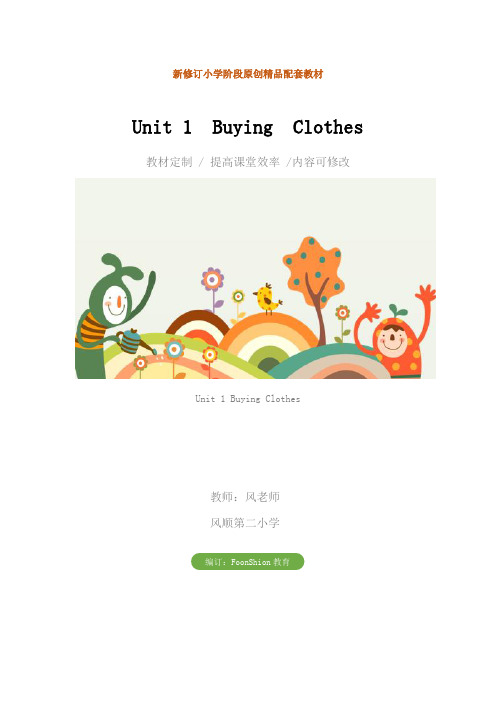
新修订小学阶段原创精品配套教材Unit 1 Buying Clothes 教材定制 / 提高课堂效率 /内容可修改Unit 1 Buying Clothes教师:风老师风顺第二小学编订:FoonShion教育Unit 1 Buying Clothesunit 1 buying clothesi. subjects1. vocabulary:can, help, buy, much, yuan, dress (4 skills)shop assistant, clothes, take (3 skills)2. can i help you? i’d like to buy….how much is it? it’s….3. culture: “yuan”——外来语,单复同形ii. focal and difficult pointscan i help you? i’d like to….how much is it? it’s…i’ll take itiii. processes1. leading ina. review numeralsten, twenty… ninety → ninety yuan (show) “yuan” 外来语,单复同形b. p1 t: guess! which one is worth 90 yuan?yes, the dress. (教dress pl dresses)2. presentationa. p2 t: now, the woman is shopping at the shop.→ t分饰两角,重复对话两次配合动作让生了解对话。
b. 第三次边说边板书,并教新单词:t: 带读重难句:can i help you?yes, please. i’d like to buy that dress.how much is it ?i’ll take it.c. ps try to listen to the tape after teacher’s guide, then read after the tape (2 times)3. practicea. read in pairsb. ask students to readc. use coat, shirt, skirt, jacket, instead of dress (teach the new words) (p3 dialogue 3a)4. summing upa. whole class read the new wordsb. 请生总结购买单数物品的说法homework:1.① 完成对话2.recide the dialogue3.p5 ex.1shop assistant: good afternoon can i help you? lily: yes, please. i’d like to buy that jacket.how much is it?shop assistant: it’s eight-five yuan.lily: ok. i’ll take it.板:module 1 unit buying clothes10 s a: good morning. can i help you? much12 20 w: yes, please. i’d like to buy that dress. can13 30 how much is it? help14 40 s a: it’s ninety yuan dress15 50 w: ok. i’ll take it take16 60 boat coat17 70 shirt18 80 skirt19 90 yuanunit 1 buying clothesi. objectives1. vocabularyjeans, them, trousers, shorts, shoes, socks, a pair of2. how much are they? they’re….i’ll take them3. focal pointsa pair of …how much are they? they’re…4. difficult pointsa pair of shoes / trousers…i’d like to buy those jeansii. processes1. leading in(1) listen to the tape and read the dialogue (a)(2) try to retell dialogue (a)(3) role play2. presentation(1) t: i have 49 yuan (show) i’d like to buy a dress. what cani say?(2) ask 2 students try to act out after teacher’s guide.(3) t: i don’t want to buy the dress now.please turn to p1. guess, what else i want to buy?t: yes, jeans. (教读jeans)(4) 牛仔裤有两条裤管,一直要用复数jeans(5) 那么,怎样表达“一条牛仔裤”?use: a pair of jeans.(6) 在p1找出要用a pair of 表示“一条/ 一对/ 一双”的物品:教:trousers, shorts, shoes, boots, socks读音→ 拼写→ 记忆(7) t: now, i’m the customer (顾客) in the shopi want to buy those jeans. (show)and you’re the shop assistant.what will you say? (guide)根据上节的板书,边说边把板书部分改为:that + dress → those jeansis it → are theyit’s → they’rei’ll take it → i’ll take them(8) read the dialogue after the teacher(9) read after the tape(10) read in pairs(11) (guide) try to retell the dialogue (4 pairs)3. summing up今天学习了购买什么样的物品的说法?4. practice and developmentp3 3. complete the dialogue bhomework:1.copy the new words2.recide the dialogue3.act out the dialogue in pairs板:unite 1 buying clothes----- good morning. can i help you? a pair of jeans----- yes, please. i’d like to trousersbuy those jeans. shortshow much are they? shoes----- they’re forty-nine yuan boots----- ok. i’ll take themunit 1 buying clothesi. objectives1. let’s learn together2. vocabulary, twenty, thirty, fifty, eighty, hundred, osport shoes, sweater, jacket3. review: how much is it / are they?it’s / they’re…ii. processes1. leading in(1)role play: dialogue 2 (a) & (b)2. presentation(1)count the numbers (以前学过,不作为难点) (板) 11 eleven 10 ten12twelve 20 twenty13thirteen 30 thirty14fourteen 40 forty15fifteen 50 fifty16sixteen 60 sixty17seventeen 70 seventy18eighteen 80 eight19nineteen 90 ninety100 hundnd(2) p5. let’s karn together 1 (check)ask ps to write their answers on the bl.(板) * thirty—nine (连接符号书写)(3) p5. ex. 2. teach: sport shoest: for example – how much is the shirt?-- it’s 30 ynan-- how much are the jeans?-- they’re 220 yuana.do by themselvesb.check the answers. (one by one)(4) p6. fun with englishfor examplet: look at picture a. the boy’s shirt is black and his shorts are red. his sport shoes are yellow and white. his long socks are green.homework:1.copy the new words (and remember)2.p6. ex. 1 fun with english3.《活》p3 ex.4 ex.5 (师要先举例)4.listen to the tape unit 1 (3 times)FoonShion教育研究中心编制Prepared by foonshion Education Research Center。
Unit1lesson1SkirtandTrousers(课件)冀教版英语四年级上册

What clothes does the girl like?
A.
B.
What is the boy’s favourite
colour?
A. red
B. yellow
Listen and repeat
This
a red skirt
is
.
I like it.
These are yellow trousers. Yellow is my favourite colour.
These are trousers. —What is Jenny wearing? —She is wearing a red sweater.
Exercise
A. shirt B. skirt C. sweater D. Trousers E.T-shirt
1. ( ) 2. ( ) 3. ( ) 4. ( ) 5. ( )
4 Let’s play! What is she wearing?
Group work. Listen and guess.
Yang Meng.
She is wearing a _y_e_ll_o_w_ _T_-_sh__ir_t.
Wang Li.
What is she wearing?
Yes.
She is wearing ______and He is wearing _______and
__. _____.
Today,Jenny will go to school. But,Oh no!what’s wrong with her clothes?
What is
?
This is a
Shirt, shirt, this is a shirt.
四年级上册英语-Unit1 Lesson1 Skirt and trousers 冀教版

四年级上册英语-Unit1 Lesson1 Skirt and Trousers 冀教版单元介绍本单元将介绍衣服的种类,并且学习如何用英文来描述它们。
在这个单元里,你会学习到一些基本的单词,比如说“skirt”(裙子),“trousers”(裤子)等。
Lesson1 Skirt and Trousers单词学习在这一课里,我们将学习两个单词,分别是“skirt”和“trousers”。
下面是这两个单词的含义和拼写方式:•skirt([skərt]):裙子。
•trousers([ˈtraʊzəz]):裤子。
掌握语句在学习了新的单词之后,我们可以通过以下句子来帮助我们掌握这些单词:1.What’s this?(这是什么?)2.It’s a skirt.(这是一条裙子。
)3.What are these?(这些是什么?)4.They are trousers.(它们是裤子。
)学习重点在这一课里,我们需要学习如何回答关于衣服的问题。
我们可以通过以下几点来加强对该课程的掌握:•学会认识和拼写新的单词。
•学会如何回答“这是什么?”和“这些是什么?”等问题。
•学会用英文询问别人正在穿的衣服。
复习练习词汇总结在本课中,我们学习了关于衣服的英文词汇。
以下是本课中用来描述衣服的词汇:•skirt(裙子)•trousers(裤子)课程练习以下是一些练习题以加强对本课的掌握:1.What’s this?(这是什么?)–A. A skirt.(一条裙子。
)–B. Trousers.(裤子。
)–C. Both A and B.(两者都是。
)–D. None of the above.(以上都不是。
)2.What are those?(那些是什么?)–A. Skirts.(裙子。
)–B. Trousers.(裤子。
)–C. Both A and B.(两者都是。
)–D. None of the above.(以上都不是。
)3.Can you spell。
冀教版英语四年级上册 Unit 1 The Clothes We Wear

②Let's do it!
③Is this your cap?
Is this your cap, Danny?
No! It’s Kim’s cap.
③Is this your cap?
Danny, are these your gloves?
No, Miss Zhang. See?
Yes, Danny. I see!
Is it ...?
Practice No. They're...
Are they ...?
Practice No. It's ...
Is it ...?
Language points
3. I like your skirt. 我喜欢你的裙子。 详解: 这是一个表达喜好的句子, like意为“喜 欢”,后可直接接名词,表示喜欢某物。 例句: I like your new bag.
These are books.
Language points
拓展: be动词用法口诀 我(I)用 am,你(you)用 are, is 连接他(he),她(she),它(it), 单数 is,复数 are
②Let's do it!
Look and write.
This is an old T-shirt.
Let's imitate
Let's play
介绍自己的朋友。
He is Danny. He is wearing a white shirt.
Let's play
He is John. He is wearing blue _t_r_o_u_se_r_s___.
Let's play
英语服装分类词汇
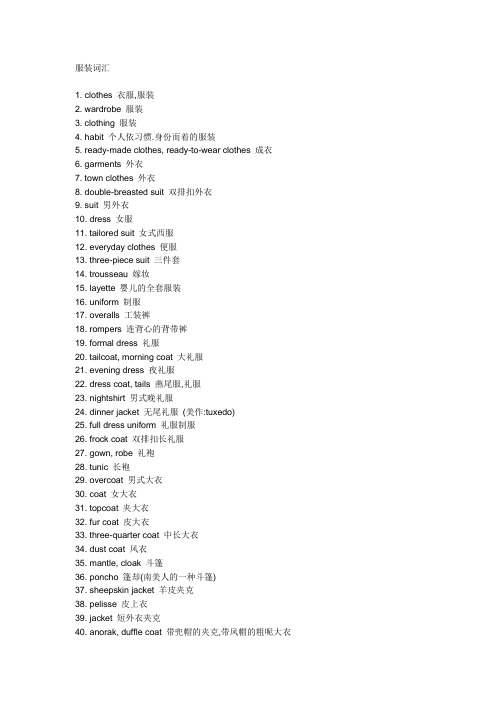
服装词汇1. clothes 衣服,服装2. wardrobe 服装3. clothing 服装4. habit 个人依习惯.身份而着的服装5. ready-made clothes, ready-to-wear clothes 成衣6. garments 外衣7. town clothes 外衣8. double-breasted suit 双排扣外衣9. suit 男外衣10. dress 女服11. tailored suit 女式西服12. everyday clothes 便服13. three-piece suit 三件套14. trousseau 嫁妆15. layette 婴儿的全套服装16. uniform 制服17. overalls 工装裤18. rompers 连背心的背带裤19. formal dress 礼服20. tailcoat, morning coat 大礼服21. evening dress 夜礼服22. dress coat, tails 燕尾服,礼服23. nightshirt 男式晚礼服24. dinner jacket 无尾礼服(美作:tuxedo)25. full dress uniform 礼服制服26. frock coat 双排扣长礼服27. gown, robe 礼袍28. tunic 长袍29. overcoat 男式大衣30. coat 女大衣31. topcoat 夹大衣32. fur coat 皮大衣33. three-quarter coat 中长大衣34. dust coat 风衣35. mantle, cloak 斗篷36. poncho 篷却(南美人的一种斗篷)37. sheepskin jacket 羊皮夹克38. pelisse 皮上衣39. jacket 短外衣夹克40. anorak, duffle coat 带兜帽的夹克,带风帽的粗呢大衣41. hood 风帽42. scarf, muffler 围巾43. shawl 大披巾44. knitted shawl 头巾,编织的头巾45. fur stole 毛皮长围巾46. muff 皮手筒47. housecoat, dressing gown 晨衣(美作:duster)48. short dressing gown 短晨衣49. bathrobe 浴衣50. nightgown, nightdress 女睡衣51. pyjamas 睡衣裤(美作:pajamas)52. pocket 衣袋53. lapel (上衣)翻领54. detachable collar 假领,活领55. wing collar 硬翻领,上浆翻领56. V-neck V型领57. sleeve 袖子58. cuff 袖口59. buttonhole 钮扣孔60. shirt 衬衫61. blouse 紧身女衫62. T-shirt 短袖圆领衫,体恤衫63. vest 汗衫(美作:undershirt)64. polo shirt 球衣65. middy blouse 水手衫66. sweater 运动衫67. short-sleeved sweater 短袖运动衫68. roll-neck sweater 高翻领运动衫69. round-neck sweater 圆领运动衫70. suit, outfit, ensemble 套服71. twinset 两件套,运动衫裤72. jerkin 猎装73. kimono 和服74. ulster 一种长而宽松的外套75. jellaba, djellaba, jelab 带风帽的外衣76. cardigan 开襟毛衣77. mac, mackintosh, raincoat 橡胶雨衣78. trousers 裤子79. jeans 牛仔裤80. short trousers 短裤81. knickers 儿童灯笼短裤82. knickerbockers 灯笼裤83. plus fours 高尔夫球裤,半长裤84. braces 裤子背带(美作:suspenders)85. turnup 裤角折边,挽脚86. breeches 马裤87. belt 裤带88. skirt 裙子89. divided skirt, split skirt 裙裤90. underskirt 内衣91. underwear, underclothes 内衣裤92. underpants, pants 内衣裤(美作:shorts)93. briefs 短内裤,三角裤94. panties 女短内裤95. knickers 女半短内裤,男用灯笼短裤96. brassiere, bra 乳罩97. corselet 紧身胸衣98. stays, corset 束腰,胸衣99. waistcoat 背心100. slip, petticoat 衬裙101. girdle 腰带102. stockings 长袜103. suspenders 袜带(美作:garters)104. suspender belt 吊袜腰带(美作:garter belt) 105. socks 短袜106. tights, leotard 紧身衣裤107. handkerchief 手帕108. bathing trunks 游泳裤109. bathing costume, swimsuit, bathing suit 游泳衣110. bikini 比基尼泳衣111. apron 围裙112. pinafore (带护胸)围裙113. shoe 鞋114. sole 鞋底115. heel 鞋后跟116. lace 鞋带117. moccasin 鹿皮鞋118. patent leather shoes 黑漆皮鞋119. boot 靴子120. slippers 便鞋121. sandal 凉鞋122. canvas shoes, rope soled shoes 帆布鞋123. clog 木拖鞋124. galosh, overshoe 套鞋125. glove 手套126. tie 领带(美作:necktie)127. bow tie 蝶形领带128. cravat 领巾129. cap 便帽130. hat 带沿的帽子131. bowler hat 圆顶硬礼帽132. top hat 高顶丝质礼帽133. Panama hat 巴拿马草帽134. beret 贝蕾帽135. peaked cap, cap with a visor 尖顶帽136. broad-brimmed straw hat 宽边草帽137. headdress 头饰138. turban 头巾139. natural fabric 天然纤维140. cotton 棉141. silk 丝142. wool 毛料143. linen 麻144. synthetic fabric 混合纤维145. acryl 压克力146. polyester 伸缩尼龙147. nylon 尼龙148. worsted 呢料149. cashmere 羊毛150. patterns 花样151. tartan plaid 格子花(美作:tartan) 152. dot 圆点花153. stripe 条纹154. flower pattern 花纹花样155. veil 面纱。
北师大版英语一年级下册《Clothes》Lesson1教案
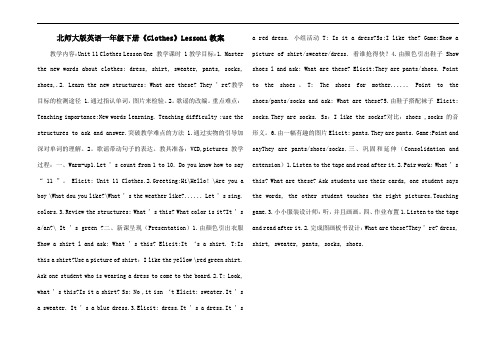
北师大版英语一年级下册《Clothes》Lesson1教案教学内容:Unit 11 Clothes Lesson One 教学课时 1教学目标:1. Master the new words about clothes: dress, shirt, sweater, pants, socks, shoes,.2. Learn the new structures: What are these? They ’re?教学目标的检测途径 1.通过指认单词,图片来检验。
2。
歌谣的改编。
重点难点:Teaching importance:New words learning. Teaching difficulty :use the structures to ask and answer.突破教学难点的方法 1.通过实物的引导加深对单词的理解。
2。
歌谣带动句子的表达。
教具准备:VCD,pictures教学过程:一、Warm-up1.Let ’s count from 1 to 10. Do you know how to say “ 11 ”。
Elicit: Unit 11 Clothes.2.Greeting:Hi\Hello!\Are you a boy \What dou you like?\What ’s the weather like?...... Let ’s sing. colors.3.Review the structures: What ’s this? What color is it?It ’s a/an?\ It ’s green ?二、新课呈现(Presentation)1.由颜色引出衣服Show a shirt l and ask: What ’s this? Elicit:It ‘s a shirt. T:Is this a shirt?Use a picture of shirt:I like the yellow \red green shirt. Ask one student who is wearing a dress to come to the board.2.T: Look, what ’s this?Is it a shirt? Ss: No ,it isn ‘t Elicit: sweater.It ’s a sweater. It ’s a blue dress.3.Elicit: dress.It ’s a dress.It ’s a red dress. 小组活动T: Is it a dress?Ss:I like the? Game:Show a picture of shirt/sweater/dress. 看谁抢得快?4.由颜色引出鞋子Show shoes l and ask: What are these? Elicit:They are pants/shoes. Point to the shoes。
四年级英语上册Unit1TheClothesWeWearLesson1SkirtandTrousers教案设计冀教版(三起)
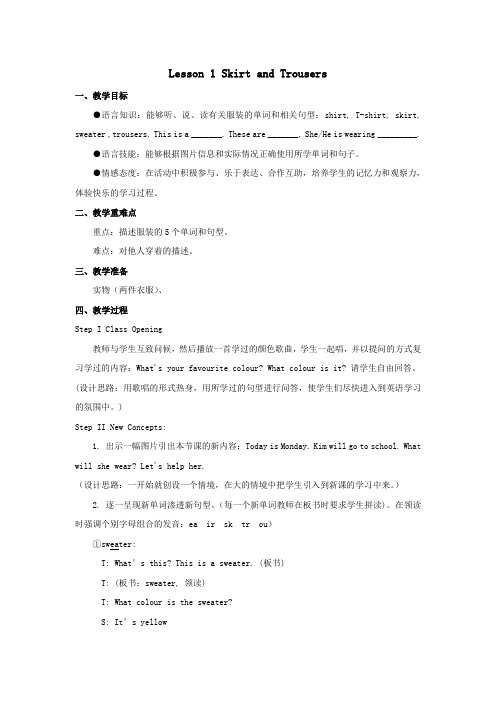
Lesson 1 Skirt and Trousers一、教学目标●语言知识:能够听、说、读有关服装的单词和相关句型:shirt, T-shirt, skirt, sweater ,trousers. This is a _______. These are _______. She/He is wearing _________.●语言技能:能够根据图片信息和实际情况正确使用所学单词和句子。
●情感态度:在活动中积极参与、乐于表达、合作互助,培养学生的记忆力和观察力,体验快乐的学习过程。
二、教学重难点重点:描述服装的5个单词和句型。
难点:对他人穿着的描述。
三、教学准备实物(两件衣服)、四、教学过程Step I Class Opening教师与学生互致问候,然后播放一首学过的颜色歌曲,学生一起唱,并以提问的方式复习学过的内容:What's your favourite colour? What colour is it? 请学生自由回答。
(设计思路:用歌唱的形式热身,用所学过的句型进行问答,使学生们尽快进入到英语学习的氛围中。
)Step II New Concepts:1. 出示一幅图片引出本节课的新内容:Today is Monday. Kim will go to school. What will she wear? Let's help her.(设计思路:一开始就创设一个情境,在大的情境中把学生引入到新课的学习中来。
)2. 逐一呈现新单词渗透新句型。
(每一个新单词教师在板书时要求学生拼读)。
在领读时强调个别字母组合的发音:ea ir sk tr ou)①sw eater:T: What’s this? This is a sweater. (板书)T: (板书:sweater, 领读)T: What colour is the sweater?S: It’s yellowT: This is a yellow sweater. (领读)②T-shirt: This is a white T-shirt. Who is wearing a T-shirt? (指一些同学说:She/He is wearing a T-shirt.)③sh irt: This is a pink shirt. T: Who is wearing a shirt?(指一些同学说:She/He is wearing a shirt.)④skirt: This is a yellow skirt.(指一些同学说:She/He is wearing a skirt.)⑤trousers:These are trousers. They are blue.(ppt出示图片)She is wearing a pink shirt and a yellow skirt. She goes to school.3. Game: What’s missing? (用来练习和巩固新学过的单词)4. T: Who is wearing blue trousers?(ppt出示一组人物图片Jenny, Guo Yang, Li Ming,然后圈出Guo Yang) He is wearing blue trousers.(板书)T: What is she wearing? (圈出Jenny) She is wearing a purple skirt.(设计思路:整个新授与操练部分力求过程简单、节奏紧凑、紧扣主题,重难点突出,面向全体学生,使学生容易掌握能够学会。
冀教版第一二单元知识点总结
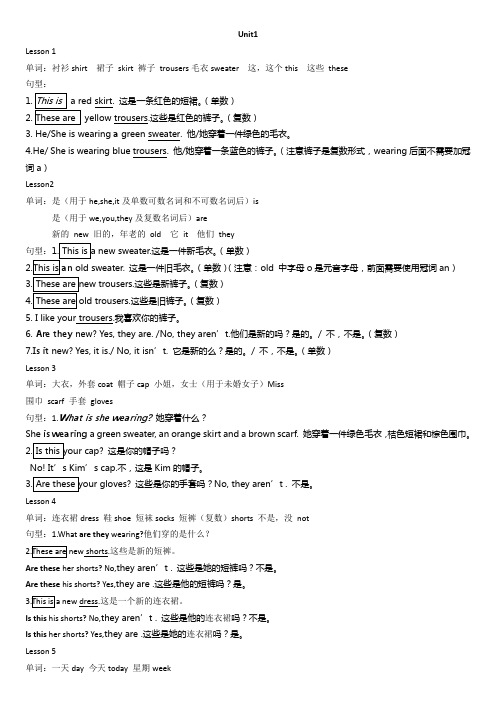
Unit1Lesson 1单词:衬衫shirt 裙子skirt 裤子trousers毛衣sweater 这,这个this 这些these句型:a red skirt. 这是一条红色的短裙。
(单数)2.yellow trousers.这些是红色的裤子。
(复数)3. He/She is wearing a green sweater. 他/她穿着一件绿色的毛衣。
4.He/ She is wearing blue trousers. 他/她穿着一条蓝色的裤子。
(注意裤子是复数形式,wearing后面不需要加冠词a)Lesson2单词:是(用于he,she,it及单数可数名词和不可数名词后)is是(用于we,you,they及复数名词后)are新的new 旧的,年老的old 它it 他们they这是一件新毛衣。
(单数)这是一件旧毛衣。
(单数)(注意:old 中字母o是元音字母,前面需要使用冠词an)这些是新裤子。
(复数)这些是旧裤子。
(复数)5. I like your trousers.我喜欢你的裤子。
6. Are they new? Yes, they are. /No, they aren’t.他们是新的吗?是的。
/ 不,不是。
(复数)7.Is it new? Yes, it is./ No, it isn’t. 它是新的么?是的。
/ 不,不是。
(单数)Lesson 3单词:大衣,外套coat 帽子cap 小姐,女士(用于未婚女子)Miss围巾scarf 手套gloves句型:1.What is she wearing?她穿着什么?She is wearing a green sweater, an orange skirt and a brown scarf. 她穿着一件绿色毛衣,桔色短裙和棕色围巾。
这是你的帽子吗?No! It’s Kim’s cap.不,这是Kim的帽子。
这些是你的手套吗?No, they aren’t . 不是。
中考英语易混词汇辨析

中考英语易混词汇辨析1. clothes, cloth, clothingclothes统指各种衣服,谓语动词永远是复数cloth指布,为不可数名词clothing服装的总称,指一件衣服用a piece of, an article of2. incident, accidentincident指小事件, accident指不幸的事故He was killed in the accident.3. amount, numberamount后接不可数名词,number后接可数名词 a number of students4. sound, voice, noisesound自然界各种各样的声音,voice人的嗓音,noise噪音I hate the loud noise outside.5. photo, picture, drawingphoto用照相机拍摄的照片,picture可指相片,图片,电影片,drawing画的画Let's go and see a good picture.6. weather, climateweather一天内具体的天气状况,climate长期的气候状况The climate here is not good for you.7. road, street, path, wayroad具体的公路,马路,street街道,path小路,小径,way道路,途径take this road; in the street, show me the way to the museum.8. course, subjectcourse课程(可包括多门科目),subject科目(具体的学科)a summer course9. custom, habitcustom传统风俗,习俗,也可指生活习惯,后接to do,habit生活习惯,习惯成自然,后接of doing.I've got the habit of drinking a lot.10. cause, reasoncause指造成某一事实或现象的直接原因,后接of sth./doing sth,reason用来解释某种现象或结果的理由,后接for sth./doing sth. the reason for being late11. exercise, exercises, practiceexercise运动,锻炼(不可数),exercises练习(可数),practice(反复做的)练习Practice makes perfect.12. class, lesson作"课"解时,两者可以替换.指课文用lesson.指班级或全体学生用class. lesson 6; class 513. speech, talk, lecturespeech指在公共场所所做的经过准备的较正式的演说,talk日常生活中的一般的谈话,讲话,lecture学术性的演讲,讲课 a series of lecture on…14. work, job二者均指工作。
冀教版四年级英语上册Unit 1 The Clothes We Wear Lesson 2课件

表示泛指,表明一类人或事物区别于它类,意思是
“一(个/本)……”。结构为 “a/an (+ 形容词) + 单数可数名词”。 例句 a shirt 一件衬衫 a red shirt 一件红色衬衫
重难点探究
重点句型
注意
为了读音的方便,在以辅音音素开头 的单数可数名词前用a;在以元音音素 开头的单数可数名词之前用an。
复习回顾
(1)Review the words about clothes.
(2)Review the phrases What’s this? It’s a… What are these?
These are …
话题导入
What’s this?It’s a …
What are these? These are …
课文原文
4. Let’s chant.
课堂互动
Practice
What’s this? It’s a … Is it new? Yes. It’s a new …
What are these?
They are …
Are these old?
No. They’re
new …
巩固练习
一、单项选择。 1. — I like your skirt. Is it new? — A. Yes, it is. B. No, they aren’t. C. Yes, they are. 2. The trousers beautiful. A. is B. was C. are 3. — What is this? — is my cat. A. These B. Those C. It
拓 展
be动词用法口诀 be 动词真伟大,生出 is, am还有are。 我(I)用 am,你
牛津初中英语AUnitVocabulary教案
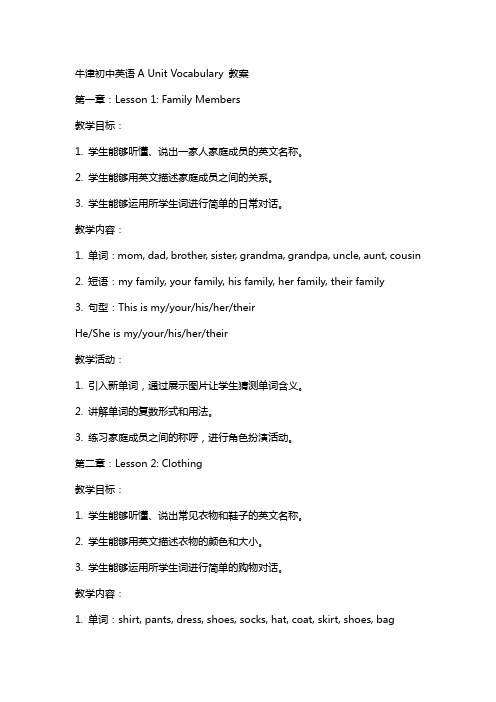
牛津初中英语A Unit Vocabulary 教案第一章:Lesson 1: Family Members教学目标:1. 学生能够听懂、说出一家人家庭成员的英文名称。
2. 学生能够用英文描述家庭成员之间的关系。
3. 学生能够运用所学生词进行简单的日常对话。
教学内容:1. 单词:mom, dad, brother, sister, grandma, grandpa, uncle, aunt, cousin2. 短语:my family, your family, his family, her family, their family3. 句型:This is my/your/his/her/theirHe/She is my/your/his/her/their教学活动:1. 引入新单词,通过展示图片让学生猜测单词含义。
2. 讲解单词的复数形式和用法。
3. 练习家庭成员之间的称呼,进行角色扮演活动。
第二章:Lesson 2: Clothing教学目标:1. 学生能够听懂、说出常见衣物和鞋子的英文名称。
2. 学生能够用英文描述衣物的颜色和大小。
3. 学生能够运用所学生词进行简单的购物对话。
教学内容:1. 单词:shirt, pants, dress, shoes, socks, hat, coat, skirt, shoes, bag2. 颜色词汇:red, blue, yellow, black, white, gray, green3. 句型:What color is it?It'sHow much is it?Can I try it on?教学活动:1. 引入新单词,通过展示图片让学生猜测单词含义。
2. 讲解单词的复数形式和用法。
3. 模拟购物场景,进行角色扮演活动。
第三章:Lesson 3: Food and Drink教学目标:1. 学生能够听懂、说出常见食物和饮料的英文名称。
四年级上册英语同步教学设计-Unit1 Lesson 1 Skirt and Trousers 冀教
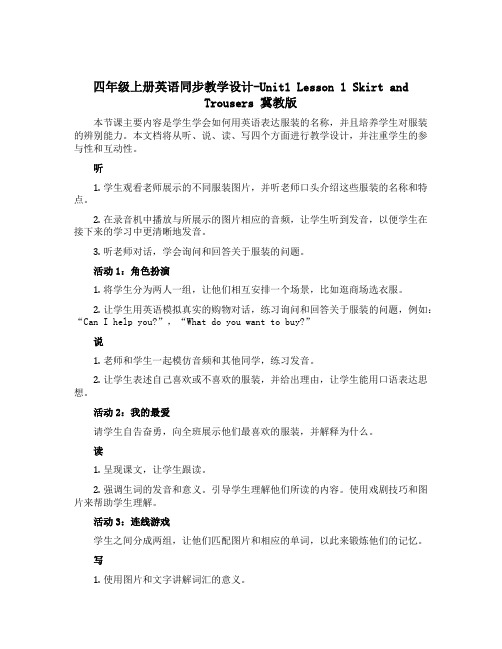
四年级上册英语同步教学设计-Unit1 Lesson 1 Skirt andTrousers 冀教版本节课主要内容是学生学会如何用英语表达服装的名称,并且培养学生对服装的辨别能力。
本文档将从听、说、读、写四个方面进行教学设计,并注重学生的参与性和互动性。
听1.学生观看老师展示的不同服装图片,并听老师口头介绍这些服装的名称和特点。
2.在录音机中播放与所展示的图片相应的音频,让学生听到发音,以便学生在接下来的学习中更清晰地发音。
3.听老师对话,学会询问和回答关于服装的问题。
活动1:角色扮演1.将学生分为两人一组,让他们相互安排一个场景,比如逛商场选衣服。
2.让学生用英语模拟真实的购物对话,练习询问和回答关于服装的问题,例如:“Can I help you?”,“What do you want to buy?”说1.老师和学生一起模仿音频和其他同学,练习发音。
2.让学生表述自己喜欢或不喜欢的服装,并给出理由,让学生能用口语表达思想。
活动2:我的最爱请学生自告奋勇,向全班展示他们最喜欢的服装,并解释为什么。
读1.呈现课文,让学生跟读。
2.强调生词的发音和意义。
引导学生理解他们所读的内容。
使用戏剧技巧和图片来帮助学生理解。
活动3:连线游戏学生之间分成两组,让他们匹配图片和相应的单词,以此来锻炼他们的记忆。
写1.使用图片和文字讲解词汇的意义。
2.学生阅读一个简短的文章并回答问题,以检验他们对所学内容的理解程度。
活动4:服装设计让学生设计他们认为合适的服装,并用英语描述它的特点。
他们可以在班级公布板上展示他们的设计。
结束语本节课目标是带领四年级学生掌握服装用英语的基础知识,通过听、说、读、写四个方面的互动活动来达成目标。
我相信通过这些技巧和活动,学生们将能够更容易地理解和掌握英语。
小学英语《Clothing》优质课教学设计、教案
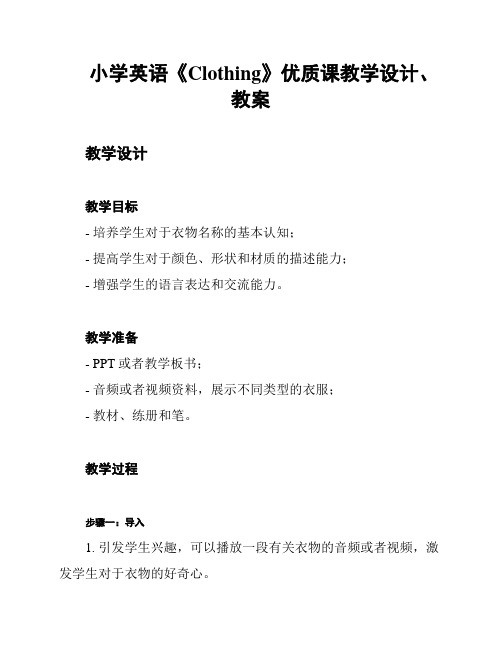
小学英语《Clothing》优质课教学设计、教案教学设计教学目标- 培养学生对于衣物名称的基本认知;- 提高学生对于颜色、形状和材质的描述能力;- 增强学生的语言表达和交流能力。
教学准备- PPT或者教学板书;- 音频或者视频资料,展示不同类型的衣服;- 教材、练册和笔。
教学过程步骤一:导入1. 引发学生兴趣,可以播放一段有关衣物的音频或者视频,激发学生对于衣物的好奇心。
步骤二:研究衣物名称1. 通过PPT或者教学板书,呈现不同类型的衣物,并帮助学生研究和记忆其名称。
步骤三:研究颜色、形状和材质1. 在PPT或者教学板书上展示不同颜色、形状和材质的衣物,引导学生对其进行描述。
2. 学生可以使用课堂上学到的词汇和句式,例如:"This is a red shirt.","It's a round hat.","The skirt is made of cotton."等等。
步骤四:练与应用1. 分发练册,并让学生完成相关的练题,巩固所学知识。
2. 可以进行口语练,让学生两两配对,描述对方穿的衣物,加强语言交流能力。
教学评估1. 观察学生在研究过程中的参与度和表现;2. 通过练册上的练题,检查学生对于衣物名称、颜色、形状和材质的掌握情况;3. 对学生口语表达进行评估,查看其在描述衣物时的准确度和流利度。
教学拓展1. 组织一次时装秀活动,让学生穿上自己喜欢的衣物进行表演,并用英语进行描述;2. 制作一个衣物展示角,学生可以自愿带来自己的衣物,并用英语进行介绍。
教案教学目标- 研究衣物的基本名称;- 提高对于颜色、形状和材质的描述能力。
教学准备- PPT或者教学板书;- 音频或者视频资料,展示不同类型的衣服;- 教材、练册和笔。
教学步骤1. 导入:通过播放音频或者视频,激发学生对于衣物的兴趣。
2. 研究衣物名称:展示不同类型的衣物,帮助学生研究和记忆其名称。
2018年冀教版四年级英语上册第一单元lesson1学会服装单词word模板最新

2018年冀教版四年级英语上册第一单元lesson1学会服装单词
word模板最新
2018年冀教版四年级英语上册第一单元重点汇总
lesson 1 学习要点:
1.学会服装单词
2. trousers本身就是复数表达这是裤子需要用“These are…”shirt skirt trousers T-shirt sweater this is these
衬衫裙子裤子T恤衫毛衣这个是这些
This is a red skirt . I like it. These are yellow trousers.
这是一件红色的裙子。
我喜欢它。
这些事黄色的长裤。
Yellow is my favourite colour. What is he wearing?
黄色是我最喜欢的颜色。
他正穿着什么?
He is wearing a green sweather. What is she wearing?
他正穿着一件绿色的毛衣。
她正穿着什么?
She is wearing a white T-shirt.
她正穿着一件白色的T恤衫。
- 1、下载文档前请自行甄别文档内容的完整性,平台不提供额外的编辑、内容补充、找答案等附加服务。
- 2、"仅部分预览"的文档,不可在线预览部分如存在完整性等问题,可反馈申请退款(可完整预览的文档不适用该条件!)。
- 3、如文档侵犯您的权益,请联系客服反馈,我们会尽快为您处理(人工客服工作时间:9:00-18:30)。
• The words cloth and clothing are related, the first meaning fabric or textile, and the second meaning fabrics used to cover the body. • 布料和服装这两个词的意思是相关联的, 前者是指面料或者纺织品,后者是指用于 遮盖人体的成衣。
• the earliest garments were made of leather and other non-fabrics, rather than of cloth, but these non-fabric garments are included in the category of clothing. • 最早的衣物不是用织物制成的,而是用皮 革或其他非织物制成的,这些非制造衣物 也属于服装大类。 • early earlier earliest
• especially today, fashion designers often use inexpensive and functional items of clothing as inspiration. • 尤其是今天,时装设计师的设计灵感常来 自于廉价面料和服装的功能性。
• reliable evidence about everyday clothing from the past can be hard to obtain because most publications and images concern the fashions of the wealthy. • 有关以往日常服装的可靠证据很难获得, 因为大多数的出版物和图片资料都只关注 富人们的服装。
lesson1 CLOTHING
List the reason why people wear clothes. 1. to cover the body and keep warm 2. to protect ourselves 3. to illustrate our personalities ...
• these sources indicate that although everyday clothing does not usually change as rapidly as fashionable dress, it does change constantly. • 这些资料表明尽管日常装不像时装变化那 么快,但它也是不断变化的。
• Fashion refers to the kinds of clothing that are in a desirable style at a particular time. • 时装是指特定时期在款式上受欢迎的各种 服装。
50年代
60年代蓝灰绿的无彩色服装时代
70年代
80年代
90年代
• However, only a small minority of people dresses in the clothing that appears in high fashion magazines or on fashion-show runways. • 然而,只有少数人的衣着会出现在高级时 装杂志或时装T型台上。
